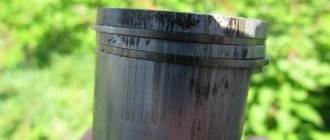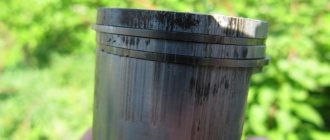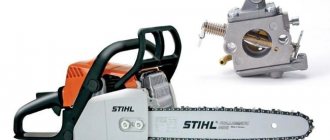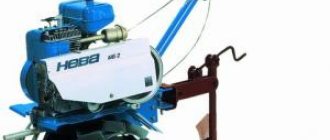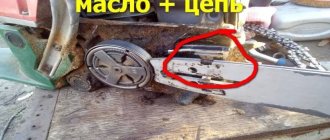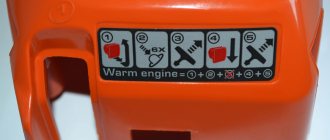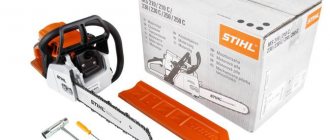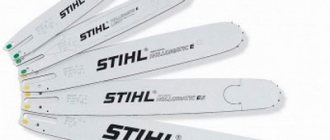A chainsaw requires regular diagnostics and periodic replacement of worn parts. With regular use, not only the saw set becomes unusable, but also the drive sprocket. In this tool, it acts as a clutch disc, which is why it bears a significant load both during startup and during operation. The sprocket on the chainsaw has a simple design, so repairs and maintenance are easy to do yourself. In this article we will look at how to determine the degree of wear of this part and carry out a planned replacement.
Drive star device on a chainsaw
Almost all models of modern chainsaws use a centrifugal clutch system. The specificity of this mechanism is that when the maximum number of revolutions of the gasoline engine is reached, the clutch drum starts automatically, transmitting rotation specifically to the drive sprocket. This reduces stress on the tool's underlying parts, extending tool life and peak performance.
Figure 1 – Diagram of the drive star device
The clutch drum, where the sprocket is located, can be located on the inside or outside of the chainsaw body. There is always a cover on top to protect moving mechanisms from dirt, sawdust and dust. The clutch itself is a metal disc located in the coupling drum. The entire mechanism is attached to the engine crankshaft with bolts and springs, along the edges of which there are friction linings. When the engine speed exceeds a certain value, centrifugal force occurs, exerting strong pressure on the inside of the drum. After this, the sprocket starts up and the chain saw begins to rotate.
Important ! It is the sprocket that drives the chainsaw chain. All parts of this mechanism are closely interconnected; failure of the headset leads to disruption of the instrument.
Chainsaw Partner 350: DIY repair, video
Today, almost every household has a chainsaw, which is a worthy replacement for axes and hand saws. The ideal solution for people living in a private house or involved in construction would be the Partner 350 hand chainsaw. This tool from a Swedish manufacturer is very convenient and compact, so it is suitable for any work in the garden.
However, improper care and intensive use of the unit can lead to its breakdown. In this case, it is not necessary to immediately contact a service workshop. Many problems can be fixed with your own hands. To do this, just study the structure of the saw and video instructions for its repair.
Types of stars
Depending on the class of chainsaw, all sprockets are divided into two groups - professional and household. The first type of parts have increased wear resistance and are made of durable metal alloys that are not subject to corrosion and mechanical damage. Household ones more often require replacement and scheduled repairs; if the tool is actively used, diagnostics are recommended every six months. Based on their design features, the following types of sprockets can be distinguished:
- Prefabricated . The removable crown can be easily unscrewed from the drum axis, which simplifies checking and replacing this part. Almost all European chainsaw models are equipped with such stars.
- Solid . They consist of a hub and a stationary crown (the number of teeth may vary; you must carefully read the instructions for the chainsaw). Due to the factory press fit, the ring cannot be removed separately from the hub, so in the event of a breakdown it is necessary to disassemble the entire clutch drum. This mechanism is usually found on Chinese models.
If you plan to service the chainsaw yourself, it is recommended to purchase a tool with a professional type of drive sprocket. It should be collapsible, which reduces the cost of repair and maintenance of the instrument.
When is replacement necessary?
The saw set and drive sprocket are subject to natural wear and tear during operation. This is not a breakdown, but a planned tool maintenance procedure. Reasons for replacing the sprocket:
- intensive and prolonged use of the saw;
- mechanical shocks of the headset;
- Using an unsuitable chain.
Figure 2 – Chainsaw chainsaw chainsaw
Normal wear on the teeth of the drive sprocket is up to 0.5 mm. With regular use, this figure can reach up to 1 mm, but over time this will lead to a load on the engine and damage to other parts of the saw. The need for replacement or repair can be determined by the following signs:
- there is mechanical damage on the guide sprocket;
- the width of the teeth is disproportionate to their height;
- there are asymmetrical angles;
- There are chips, grooves or large burrs on the hub.
Are there ways to extend the life of an existing sprocket?
The main ways to extend the working life of a chainsaw drive sprocket:
- use several chains (preferably three). This method is the most gentle and convenient for the chainsaw owner in that there is no need to constantly tighten a chain worn out by intensive work. Operating three chains in turn will save the life of the sprocket and delay its replacement;
- high-quality maintenance of the drive sprocket bearing. This part plays an important role in the functioning of both the drive sprocket and the engine. For lubrication, it is recommended to use a special lubricant. The sprocket bearing is not constantly engaged, but only at idle speed, and therefore requires periodic lubrication. You can use a tire nose lubricant, such as standard lubricant from Repsol or Husqvarna.
How to change a star on a chainsaw?
If the chain begins to vibrate even at low speeds, the chainsaw can be used for a long time without replacing parts - it is required
carry out diagnostics and, if necessary, change the components of the saw set. For a planned replacement, you will need a new clutch drum or wheel, depending on the specific model, and a basic set of tools:
- spark plug key;
- cable up to 15 cm long or piston stopper;
- factory key for removing the coupling;
- adjustable wrench or wrench.
Figure 3 - Necessary tools for replacing the star
It is recommended to have a round file, pliers, a vice and a knife to eliminate defects in the design of the chain set (if only tooth correction is required).
How to unscrew?
It is easy to remove and replace this part yourself. Working technology:
- Attach the piston to the saw cylinder. To begin, remove the protective cover on the housing, the air filter and unscrew the spark plug. Install a special piston stopper into the hole formed; instead, you can use a thick nylon cord or wire up to 15 cm long. If the piston is in the way, you can slightly turn the sprocket or move the chain clockwise.
- Unscrew the bolts on the cover that secures the tire, remove the protective casing. Loosen the chain tension or remove the saw attachment. At the same time, you can clean it from dust, dirt and sawdust.
- Depending on the model, the sprocket acts as an element of the clutch drum or is built in separately. In the second option, remove this part and replace it with a new one. The one-piece design is difficult to repair - the unit must be disassembled. To do this, unscrew the coupling clockwise and remove the drum. Check structural parts for wear and deformation.
Figure 4 – Replacing the star with a new one
If the sprocket is an element of the clutch drum, then the entire part will have to be replaced. When replacing, you should pay attention to the suitability of the model - it must be similar to the factory one.
How to assemble?
Assembly of the coupling mechanism should be carried out in the reverse order. First install the sprocket on the needle bearing, then put on the drum, washer, gasket and the clutch itself. Tighten counterclockwise and secure the piston with a slight movement.
If the chainsaw has an oil drive spring, it may be built into the drive sprocket. In most models, the correct location of this element is marked with a special color or notch. To get to the desired position, turn the sprocket until it clicks.
The last stage of assembly is installing the saw bar. During this process, you need to release the handbrake and then check that the chain teeth are in the correct slots. After installation, mount the chainsaw chain to working condition. Finally, remove the stopper, screw in the spark plug and replace the filter. The final repair step is to secure the protective housing cover.
Important ! When removing a chainsaw sprocket, clutch or clutch drum, it is recommended to take the part with you to the store. This will allow you to choose a suitable analogue.
Features of replacing a star for chainsaws of different brands
When replacing or repairing a chainsaw, you should take into account the design features of the model. Specifics of servicing coupling drums from popular manufacturers:
- Stihl (Calm) . Models of this brand have one-piece and collapsible types of sprockets. To unwind the clutch you will need a 19mm socket and a wrench. Please note that the thread is left-handed, and a reflective plate is installed behind the clutch (a consumable material that often breaks when diagnosing the drum).
- Partner (Partner) . The peculiarity of this brand is that when replacing a sprocket, it is recommended to change the bearing as well. If you ignore this step, after scheduled repairs there is a risk of disruption of the chain and a change in the pitch during active sawing.
- Husqvarna (Husqvarna) . Many Husqvarna models use a sprocket with a replaceable ring. This simplifies routine replacement and repairs. When disassembling the tool, you will need a 13mm wrench to fix the shaft from the impeller side.
- Carver (Carver ). Unlike other manufacturers, there are no specific clutch design features. Depending on the brand, the star can be solid or collapsible.
How to reduce drive sprocket wear?
The service life of a chainsaw clutch can be increased by routine maintenance and high-quality maintenance of the tool. Helpful Tips:
- Apply grease to the needle bearing after each sprocket replacement;
- correctly select all parts of the saw set depending on the chain pitch, use reliable consumables;
- do not replace parts of the clutch and saw at the same time - this leads to a change in pitch and wear of the headset;
- Clean the saw regularly by removing the side guard.
During operation, you should carefully monitor the sound and behavior of the circuit. If it begins to jam, vibration and rattling appear - diagnostics are required.
Replacing the sprocket in a chainsaw is a planned procedure that ensures reliable and stable operation of the tool. When diagnosing or repairing the coupling mechanism, the design features of the model and the manufacturer’s requirements should be taken into account. To avoid frequent breakdowns, it is recommended to use only original parts or high-quality analogues, and systematically clean the chainsaw.
A little about the rules for operating the node
All chainsaws, regardless of the manufacturer, are divided into:
- Household. Low power. Designed for small amounts of home repair work. Duration of continuous operation: half an hour - an hour. Recommended use is up to 50 hours per month.
- Semi-professional. Medium or high power Capable of working without interruption for several hours. Suitable for small construction or renovation. Monthly use is up to 100 hours.
- Professional. High power, additional functionality. Can be used continuously throughout the entire work shift. Designed for logging, medium and large construction, procurement workshops of enterprises.
They all have a similar design of the main components and high build quality. The main difference lies in the design of the working chain and the materials used for the manufacture of parts and assemblies.
Chainsaw device
The suitability of a chainsaw for use depends on the style of use of the blade and sprocket. There are usually two of them:
- The chain is used until the teeth are completely worn out. The gear is also changed along with it.
- Several chains with different pitches are used, which have their own gears corresponding to them in terms of the number of teeth and pitch.
In the first case, they cut everything, including nails and staples. This causes increased wear on both the chain and gear. You have to frequently edit and sharpen the chain, spending a lot of time on it.
The chain and sprocket should only be replaced together. During operation, the blade rollers are worn into the gear, stretching somewhat as the teeth wear. If the old chain is paired with a new sprocket (or vice versa), there will be no such correspondence.
When starting, the teeth will hit the links, which will lead to increased vibration and wear of the entire chainsaw.
The condition of the gear-blade pair also affects the operation of the clutch and drive bearing. In the “Work” mode, the crankshaft rotates. In idle mode, with the clutch disengaged, the bearing begins to rotate. If it is insufficiently lubricated, it is subject to increased wear, which causes even greater tooth runout.
Both the blade and the sprocket are subject to periodic replacement. It's better to do it at the same time
